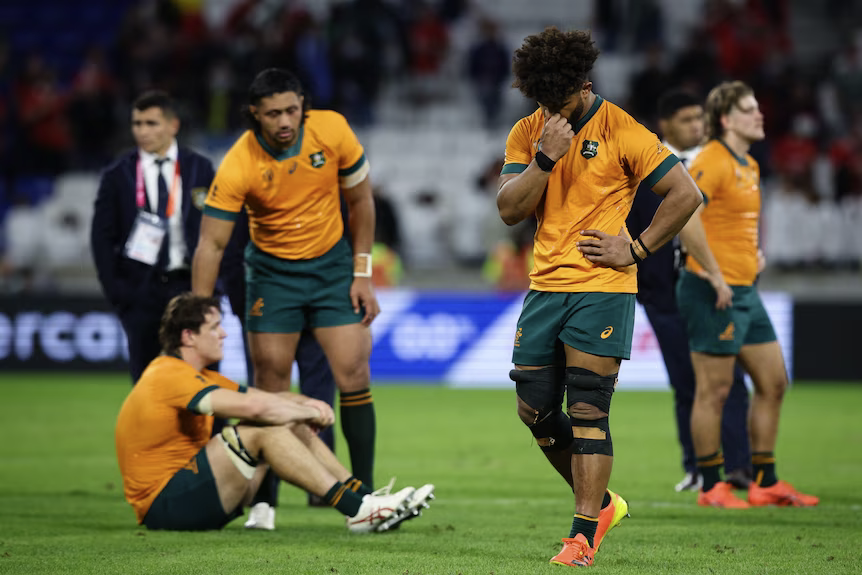How to fix Rugby (in) Australia

Rugby in Australia is at an all-time low:
- The Wallabies were knocked out of the Rugby World Cup in the group stages for the first time ever.
- Dave Rennie – hired to take the Wallabies to the World Cup – was sacked several months before the tournament even started, with Eddie Jones parachuted in, turning it into a clown show, and then walking out the door in less than a year.
- The Wallabies haven’t won the Bledisloe Cup in 22 years.
- An Australian Super Rugby club hasn’t won a title (or made a grand final) since 2014.
- The NSW Waratahs’ finances are so “perilous” that it may give up control to Rugby Australia (the central body).
- The game’s prospects are so poor that Rugby Australia couldn’t even come to terms with private equity to secure its financial future, electing instead to saddle the sport with $60m in new debt.
I’ve probably missed some but it doesn’t matter; the situation is dire. The only question that remains is what can be done to fix it?
The push for centralisation
Those at the top believe they have a solution and have repeated it ad nauseum: centralisation. The problem with Australian rugby, they claim, is that the clubs compete for players, coaches, and finances without worrying about how it might affect the Wallabies. That competition means there’s limited continuity; for example, the Wallabies’ starting front row might be playing across three different teams, and clubs regularly ‘poach’ staff, players and sponsors from each other.
According to Rugby Australia, centralisation would solve that. As the Canberra Times summarised:
“Rugby Australia is looking to take on the ownership of all franchises to align operations with a view to improving results on and off the field.
Rugby Australia officials have privately reassured all club bosses they have no intention of reducing the number of teams, or changing the way talent is distributed, but the franchises are awaiting a full proposal.
But the governing body would have the power to make any decisions it deems appropriate, including relocation, player allocation, coaching appointments or the number of teams in the competition if it controls the franchises.”
I’m not going to get into what those ‘assurances’ might be worth – those familiar with rugby in this country will remember when Rugby Australia ‘assured’ the Western Force its position in Super Rugby was safe, only to be cut a year later.
I’m also going to ignore whether it’s a good idea to have a central organisation allocating players and coaches across clubs, and what that might do to the sport itself (will fans still turn up knowing their home side has been shafted in player allocations, with no realistic chance of competing that year?).
No, what I want to discuss is the centralised model itself – is it really the panacea for Australian rugby? Proponents such as Rugby Australia’s CEO Phil Waugh claim that it is, citing other countries where it’s used:
“The best example is probably Ireland and New Zealand. They’ve been strong for a long period of time and between World Cups through their provincial teams as well as their national team.”
The problem with that logic is that those aren’t exactly stellar examples. True, they are successful rugby nations, but Ireland have still never even made it past a World Cup quarterfinal, and centralisation may be doing more harm than good in New Zealand:
“Ironically almost, All Blacks coach Ian Foster said last year that, despite the centralised policy-making, he inherited a squad of players for the Irish series who had not been well prepared by Super Rugby Pacific to play test football.
Regulating the market so to speak is no longer working, or at least the level of regulation needs to be reduced.”
Super Rugby, the competition contested by Australian and New Zealand-based clubs (and now Fiji and Samoa), hasn’t been much of a competition for some time. Rather, it has become “a national body play-thing”, with certain clubs set up to succeed via generous player top-up payments from national bodies and others left to fail.
Centralisation is no panacea
It’s no wonder fans are staying away – other than die-hard Cantabrians, who wants to see the Crusaders romp their way to a seventh consecutive title, anyway? A better option might be to reduce the influence of national bodies on the premier competition in the Southern Hemisphere:
“[Decentralisation] may lead to less uniformity and more pronounced differences in gameplans between the respective New Zealand teams, and in all probability, it will generate greater intensity of competition by driving stronger club identities and accentuating the importance of teams winning rather than individuals impressing in the hope of being selected for higher honours.
And maybe most importantly, it will encourage greater skill and tactical innovation by not having so many elite players working towards a prescribed vision of what qualities are right for their respective positions.
Centralisation worked well for a time, but it’s obvious now that it needs to be scaled back to allow a greater diversity of thinking to be injected into the system, and for Super Rugby coaches to have greater freedom to build gameplans that work best for their players.”
Rugby in Australia may not be as centralised as it is across the ditch, but Rugby Australia still has a huge influence over its Super Rugby clubs. For example, last year it instructed “key Wallabies to rest for as many as three games during the 2023 Super Rugby season”, a strategy regularly employed by centralised bodies such as in New Zealand.
More fundamentally, it also decides which players receive top-ups above and beyond the salary cap, with some “worth north of $600,000”, effectively nuking any chance of a fair competition (the players aren’t evenly distributed around the local clubs). It also controls the purse strings through centralised control over media rights, which it recently used to bully the Brumbies:
“But the issue we have got, is the way we have been treated by RA has been appalling. They had us over the barrel, financially, and the only reason they had us over the barrel goes back to the reduction in funding from the last broadcast deal. The 30 per cent they reduced our funding, by $1.7 million, is the reason that we are in financial difficulty.
They inflicted it on us and to add to it, we are doing more now. We have a Super W program and that’s a significant investment to get that up and running. We are doing far more with less money.
So for them to turn around say, ‘You have to hand back everything, we will take full control of the Brumbies’, is not acceptable.”
I don’t know about you, but the last thing I would want for Australian rugby is for even more power given to an organisation that makes ad-hoc ‘captain calls’ such as firing and hiring two head coaches in less than a year; openly bullies its own members and appears willing to cut them on a whim (excluding the NSW Waratahs) because it loves looking backwards and in the ‘good old days’ we only had 3 clubs; throws millions at rugby league stars despite not having any financial security itself; and whose Chairman and CEO continued to party it up in France “weeks after the Wallabies crashed out of the World Cup” (how out of touch can you be?).
How about instead of further centralising power under the current band of thugs, we look to further decentralise rugby in Australia? The good news is we have already have a model of where that worked very, very well: South Africa.
The South African model of decentralisation
In 2019, South Africa scrapped a rule that required overseas-based players to have at least 30 test caps to be eligible for Springboks selection (known as the ‘Giteau Law’ in Australia). It was replaced with significantly expanded top-up payments for home-based players from the governing body, with players ranked by position to determine how much extra they are paid. The goal of the new system was to abandon what was a financially futile effort to prevent their best players going overseas and instead focus on succession planning, ensuring those who do leave the Springbok set-up can be replaced.
In other words, rather than paying overs for a few stars, they built depth by spreading those payments further, something that is also in short supply in Australian rugby.
The central body also stopped meddling in club decision-making. Local franchises were left free to make their own decisions about coaching and player retention but were still effectively subsidised by the national body due to a larger number of players receiving top-ups. According to Rassie Erasmus, Director of Rugby at SA Rugby:
“The only solution that would keep everyone happy would be if we had enough money to pay the players we wanted to keep as much as they wanted to receive - but that’s not the world we live in.
We’ve got to deal with the practical realities and stay focused on our objective, which is to field the best available 23 players who really want to play for the Springboks and who are prepared to make sacrifices whether they are playing here or overseas.
We only have a limited budget to do that, but we have many players who have the potential to become Springboks. This way, we can give them that message in a practical way.
They will know that there is a future for them with the Springboks and that they can move up the succession ladder if their play merits it.”
How did it work out? Unlike Ireland and New Zealand, South Africa has won two consecutive World Cups since adopting a decentralised model. Of course there are many factors at play, but two Cups in a row from a nation with far fewer resources than other countries suggests it can’t be all that bad.
Consider all the options
Rugby Australia (which also has a ’limited budget’) could learn a lesson a lesson or two from the success of South Africa. For example, it could immediately scrap the Giteau Law. It could double the number of local players contracted to the Wallabies, to be determined through a new independently determined position ranking system. And it should allow players and coaches to move wherever in the World they can earn the most, diffusing what they learn to their Wallabies teammates when they get together for up to 14 weeks of the year (as per World Rugby Regulation 9).
Not only would that improve depth for the Wallabies, but it would help to restore true competition to Super Rugby and bring back the fans. Having an actual competition, despite the absence of many Springboks, certainly hasn’t deterred fans in South Africa:
“Over 1.6 million fans will have attended games by the time the final whistle is blown to crown the 2022/23 champions.
The tournament’s showpiece event is yet another sell-out, with 55,000 fans expected at DHL Stadium [in Cape Town].
The URC add that average attendance in the competition has grown to just shy of 10,000 (9,893) per match for the regular season, which is the highest average the league has ever recorded.
All 16 teams have experienced an increase in average attendance compared to the 2021/22 season, with overall match attendance up 36 per cent.”
Instead of paying an extra $600,000 a year to keep Rob Valetini at the Brumbies – nothing against Rob, that’s just a top-up figure I know exists – let him go overseas and be paid what he’s worth (it’s a short career, after all). Use those savings to increase payments to many more players and prop up grassroots rugby. By doing that, you open a viable pathway to Super Rugby and the Wallabies for the next potential superstars, rather than lose them to rugby entirely. They might eventually go overseas, but they’ll still be Wallaby eligible.
If the current Rugby Australia board isn’t willing to even consider the South African model – or explain why it wouldn’t work here, or why the centralised alternative is so much better other than by boosting their own personal power and status – then they should resign and be replaced by professional sports administrators who will.
The last several years of steerage under this board – which has seen five CEOs and three head coaches come and go in as many years – have been chaotic to say the least. Regardless of what direction Australian rugby takes from here, some diverse views from outside the NSW-centric rugby bubble are desperately needed at the top of Rugby Australia. Surely we can do better than the hodgepodge of ex-players and bankers that currently occupy board seats (with apologies to Brett Godfrey and Pip Marlow, although it’s not clear what background they have, if any, in sports administration)?


Member discussion